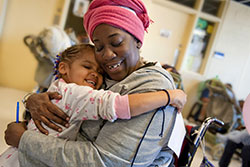Since taking office several months ago, President Biden has worked to uplift the importance of child and family nutrition. President Biden issued an executive order two days after his inauguration which began a full effort towards providing equitable economic relief across the nation. The first listed action in that executive order is to “address the growing hunger crisis facing 29 million Americans — and as many as 12 million children,” establishing the Biden Administration’s dedication to ensuring families can put and keep food on their tables.
The executive order included calls for increasing Supplemental Nutrition Assistance Program (SNAP) benefits and investing $3 billion to help women, infants and children get the food they need. Furthermore, it called on the U.S. Department of Agriculture to increase Pandemic Electronic Benefits Transfer (P-EBT) benefits, allow the lowest-income households to receive a larger allotment of SNAP benefits, and to update food assistance benefits to reflect the updated, current cost of a basic healthy diet. Noreen Springstead, Executive Director of WhyHunger, states: “It’s important to acknowledge that there’s been a huge change in the language and the desire to end childhood hunger in this massive way, and the increase in funding is at a scale we haven’t seen probably in 50 years.”
One of the Biden Administration’s early victories in combating food insecurity was the enactment of the American Rescue Plan, a $1.9 trillion economic stimulus bill signed into law on March 11, 2021 to increase the speed at which the United States recovers from the detrimental economic and health effects of the COVID-19 pandemic. The American Rescue Plan includes $12 billion devoted to mitigating the pandemic-fueled high rates of hunger and hardship. An important feature of the American Rescue Plan is a 15 percent increase in the maximum SNAP benefit. According to the Center on Budget and Policy Priorities, 2,720,000 New Yorkers participate in SNAP. With a 15 percent increase in maximum benefits, the average monthly SNAP benefit increase per New Yorker is $30, and the estimated total monthly benefit increase statewide is $81 million.
The relief bill also focuses on reducing food insecurity among children and contains numerous provisions targeted towards keeping children and young adults fed. These provisions include:
- Investing more than $5 billion to extend P-EBT throughout the summer. Under P-EBT, families who are eligible for free or reduced-price school meals receive the monetary value of these missed meals through a state-issued benefit card.
- Allotting up to $880 million to modernize and bolster the Special Supplemental Nutrition Program for Women, Infants and Children (WIC) through enrolling more eligible families and increasing the monetary value of fruit and vegetable benefits.
- Allowing young adults ages 18 to 24 who are experiencing homelessness to receive meals and snacks from homeless shelters.
Through the American Rescue Plan, the Biden Administration is launching the largest summer food program in American history. The program will allocate approximately $375 for up to 34 million low-income children for the ten weeks during which they are out of school, providing these children with reliable access to healthy meals. This provision is expected to greatly reduce food insecurity among vulnerable children. According to a 2016 study by the Department of Agriculture, allocating $60 per child each month reduced the most severe category of food insecurity among children by one third – inspiring optimism for the effectiveness of the current summer food program. Furthermore, the Brookings Institute reports that in July 2020, Pandemic EBT money reduced “food hardship” by 30 percent in the week after it was dispersed. The Biden Administration’s summer food program will likely provide unprecedented support to children facing food insecurity.
New York children will directly benefit from the Biden Administration’s significant efforts to reduce food insecurity. According to the Census Household Pulse Survey, between June 23, 2021 and July 5, 2021, 20 percent of New York households with children reported “sometimes” or “often” not having enough food. The average household with children in New York spent $283.99 on groceries during this time. However, a large disparity exists between households that have a sufficient amount of food (where the average household with children spent $268.62 on groceries) and those that “often” have an insufficient amount of food (where the average household with children spent $141.39 on groceries). The $375 low-income children will receive will be essential in helping to close the gap in food spending between households with children that have sufficient food and those that do not.
The Children’s Defense Fund fully supports expanding measures to make meals more readily available to children and to decrease the number of children and families suffering from food insecurity. In May 2021, we published a list of recommendations for Congress to consider in strengthening and expanding federal child nutrition programs. As part of these recommendations, we urged Congress to implement free school meals for all children and reimburse schools for the total cost of meals. With respect to out-of-school meals for children, we urged Congress to fund transportation to and from summer meal sites and to expand home delivery options for children without access. Additionally, we implored Congress to enable automatic enrollment for WIC and to increase the quality and diversity of food available under WIC.
The Biden Administration’s American Rescue Plan takes a crucial step towards alleviating the food insecurity effects of the COVID-19 pandemic. The fiscal support allotted towards nutrition programs demonstrates the Administration’s devotion to prioritizing children and will be essential in helping to ensure that all children – and particularly the most vulnerable – have access to food.




